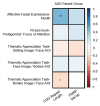A Unique Visual Attention Profile Associated With the FMR1 Premutation
- PMID: 33633778
- PMCID: PMC7901883
- DOI: 10.3389/fgene.2021.591211
A Unique Visual Attention Profile Associated With the FMR1 Premutation
Abstract
Atypical visual attention patterns have been observed among carriers of the fragile X mental retardation gene (FMR1) premutation (PM), with some similarities to visual attention patterns observed in autism spectrum disorder (ASD) and among clinically unaffected relatives of individuals with ASD. Patterns of visual attention could constitute biomarkers that can help to inform the neurocognitive profile of the PM, and that potentially span diagnostic boundaries. This study examined patterns of eye movement across an array of fixation measurements from three distinct eye-tracking tasks in order to investigate potentially overlapping profiles of visual attention among PM carriers, ASD parents, and parent controls. Logistic regression analyses were conducted to examine whether variables constituting a PM-specific looking profile were able to effectively predict group membership. Participants included 65PM female carriers, 188 ASD parents, and 84 parent controls. Analyses of fixations across the eye-tracking tasks, and their corresponding areas of interest, revealed a distinct visual attention pattern in carriers of the FMR1 PM, characterized by increased fixations on the mouth when viewing faces, more intense focus on bodies in socially complex scenes, and decreased fixations on salient characters and faces while narrating a wordless picture book. This set of variables was able to successfully differentiate individuals with the PM from controls (Sensitivity = 0.76, Specificity = 0.85, Accuracy = 0.77) as well as from ASD parents (Sensitivity = 0.70, Specificity = 0.80, Accuracy = 0.72), but did not show a strong distinction between ASD parents and controls (Accuracy = 0.62), indicating that this set of variables comprises a profile that is unique to PM carriers. Regarding predictive power, fixations toward the mouth when viewing faces was able to differentiate PM carriers from both ASD parents and controls, whereas fixations toward other social stimuli did not differentiate PM carriers from ASD parents, highlighting some overlap in visual attention patterns that could point toward shared neurobiological mechanisms. Results demonstrate a profile of visual attention that appears strongly associated with the FMR1 PM in women, and may constitute a meaningful biomarker.
Keywords: autism spectrum disorder; eye tracking; fragile X mental retardation gene; fragile X syndrome; pragmatic language; social cognition.
Copyright © 2021 Winston, Nayar, Landau, Maltman, Sideris, Zhou, Sharp, Berry-Kravis and Losh.
Conflict of interest statement
The authors declare that the research was conducted in the absence of any commercial or financial relationships that could be construed as a potential conflict of interest.
Figures




Similar articles
-
The Phenotypic Profile Associated With the FMR1 Premutation in Women: An Investigation of Clinical-Behavioral, Social-Cognitive, and Executive Abilities.Front Psychiatry. 2021 Aug 6;12:718485. doi: 10.3389/fpsyt.2021.718485. eCollection 2021. Front Psychiatry. 2021. PMID: 34421690 Free PMC article.
-
A constellation of eye-tracking measures reveals social attention differences in ASD and the broad autism phenotype.Mol Autism. 2022 May 4;13(1):18. doi: 10.1186/s13229-022-00490-w. Mol Autism. 2022. PMID: 35509089 Free PMC article.
-
Physiological regulation and social-emotional processing in female carriers of the FMR1 premutation.Physiol Behav. 2020 Feb 1;214:112746. doi: 10.1016/j.physbeh.2019.112746. Epub 2019 Nov 22. Physiol Behav. 2020. PMID: 31765665 Free PMC article.
-
Fragile X spectrum disorders.Intractable Rare Dis Res. 2014 Nov;3(4):134-46. doi: 10.5582/irdr.2014.01022. Intractable Rare Dis Res. 2014. PMID: 25606363 Free PMC article. Review.
-
Visual social attention in autism spectrum disorder: insights from eye tracking studies.Neurosci Biobehav Rev. 2014 May;42:279-97. doi: 10.1016/j.neubiorev.2014.03.013. Epub 2014 Mar 30. Neurosci Biobehav Rev. 2014. PMID: 24694721 Review.
Cited by
-
Autistic Traits Associated with the Fragile X Premutation Allele: The Neurodevelopmental Profile.Dev Neuropsychol. 2024 Jul;49(4):153-166. doi: 10.1080/87565641.2024.2351795. Epub 2024 May 16. Dev Neuropsychol. 2024. PMID: 38753030 Free PMC article. Review.
-
Electroretinographic Findings in Fragile X, Premutation, and Controls: A Study of Biomarker Correlations.Int J Mol Sci. 2025 Jul 16;26(14):6830. doi: 10.3390/ijms26146830. Int J Mol Sci. 2025. PMID: 40725073 Free PMC article.
-
The Phenotypic Profile Associated With the FMR1 Premutation in Women: An Investigation of Clinical-Behavioral, Social-Cognitive, and Executive Abilities.Front Psychiatry. 2021 Aug 6;12:718485. doi: 10.3389/fpsyt.2021.718485. eCollection 2021. Front Psychiatry. 2021. PMID: 34421690 Free PMC article.
References
Grants and funding
LinkOut - more resources
Full Text Sources
Other Literature Sources

